Copyright © 2004 South-Western. Saving, Investment, and the
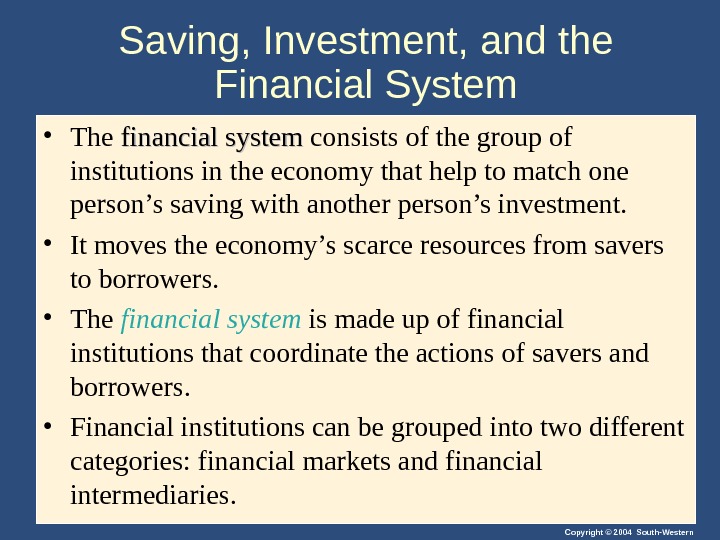
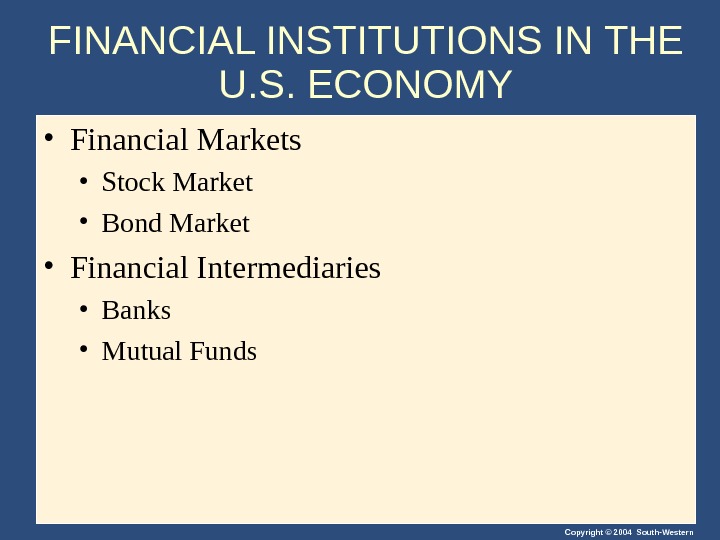
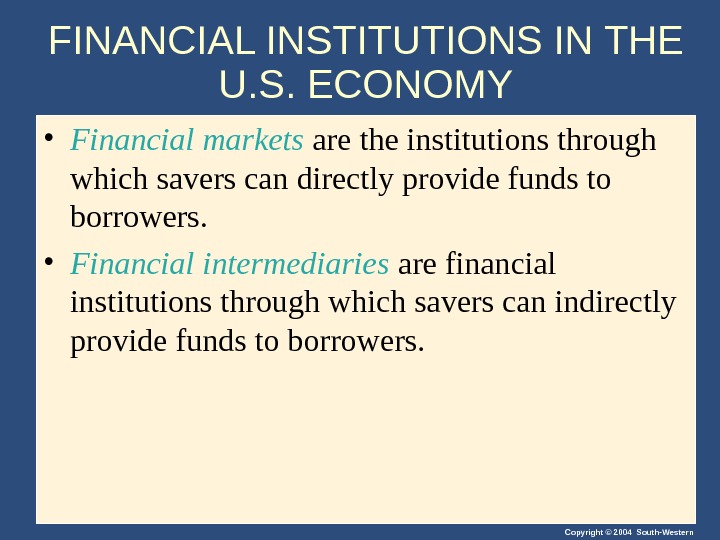

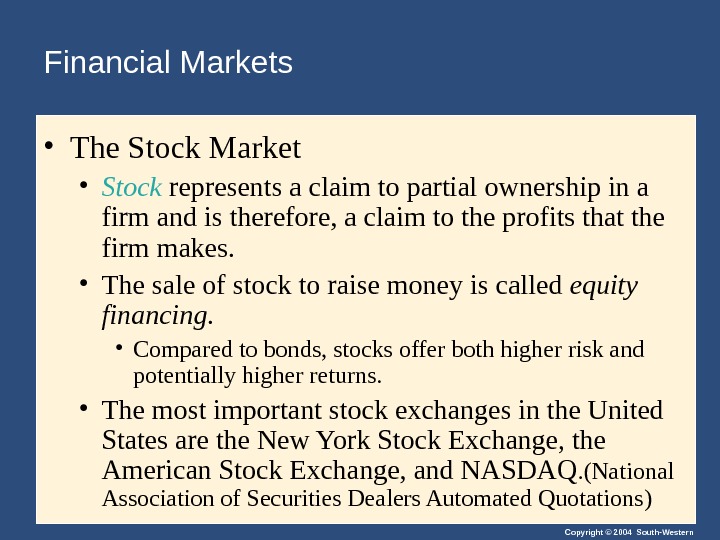
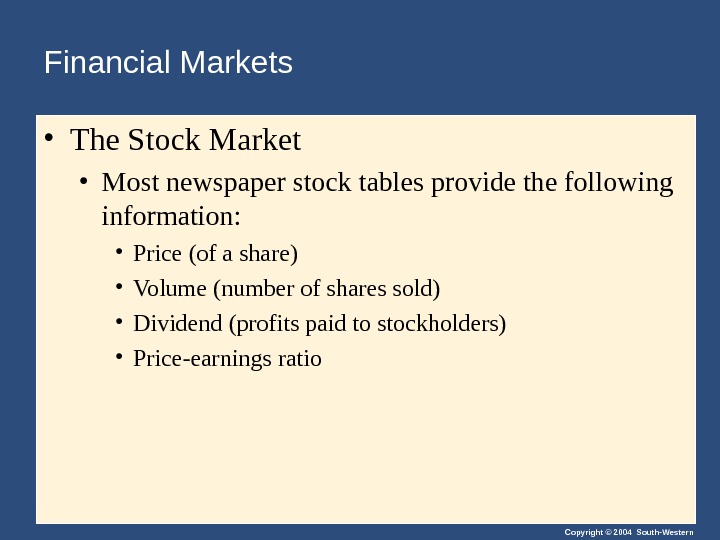

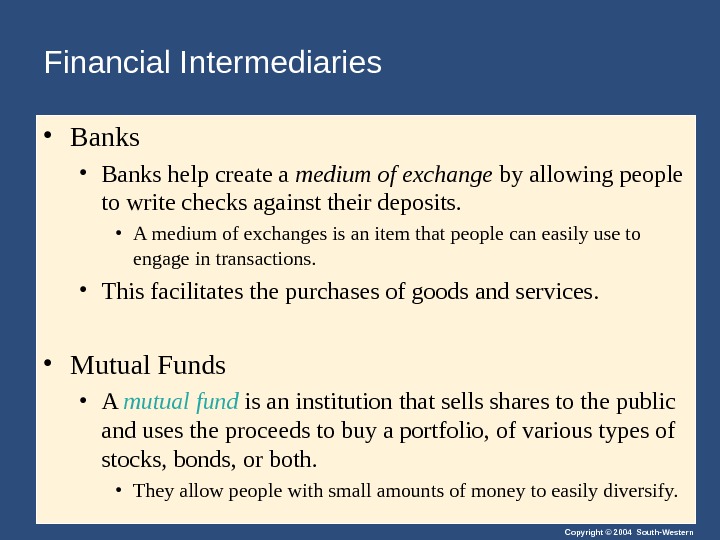
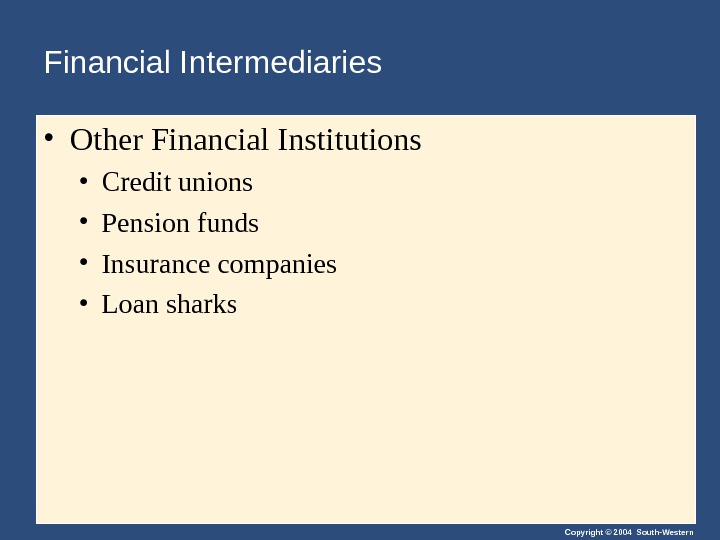
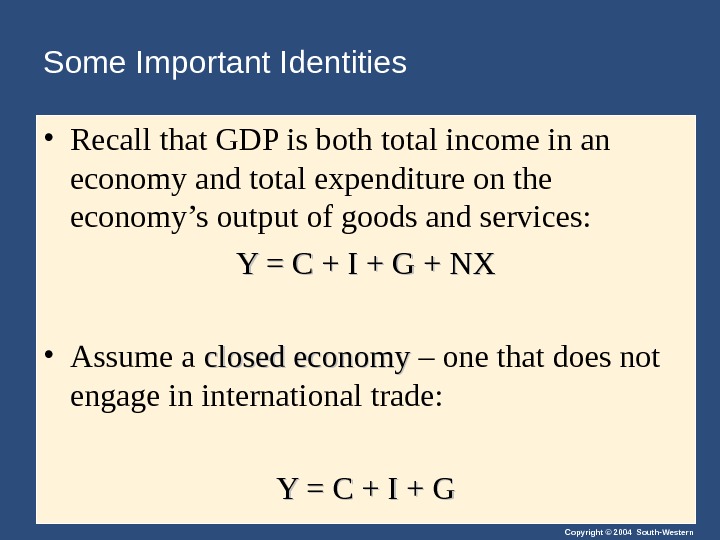
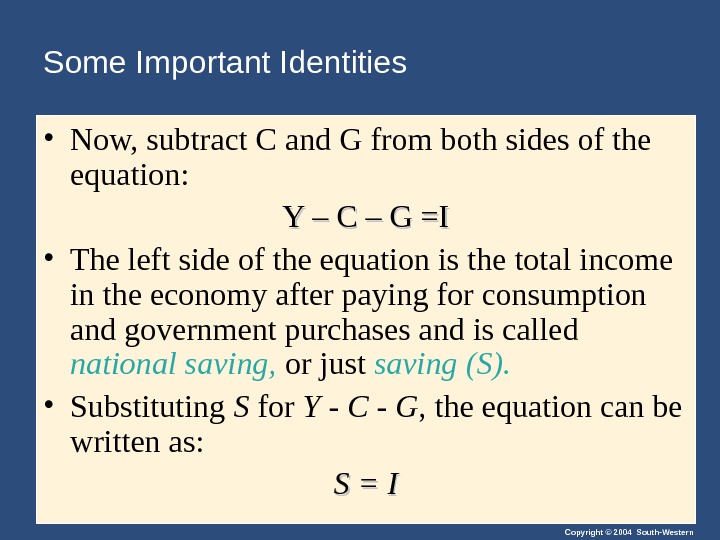
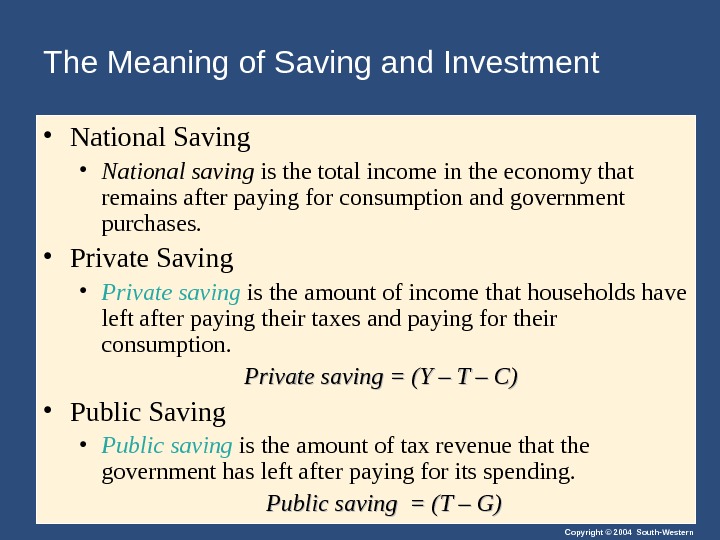
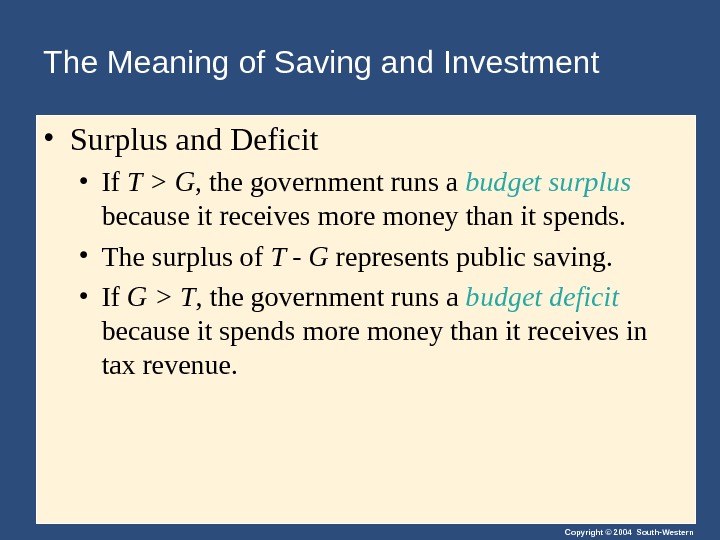
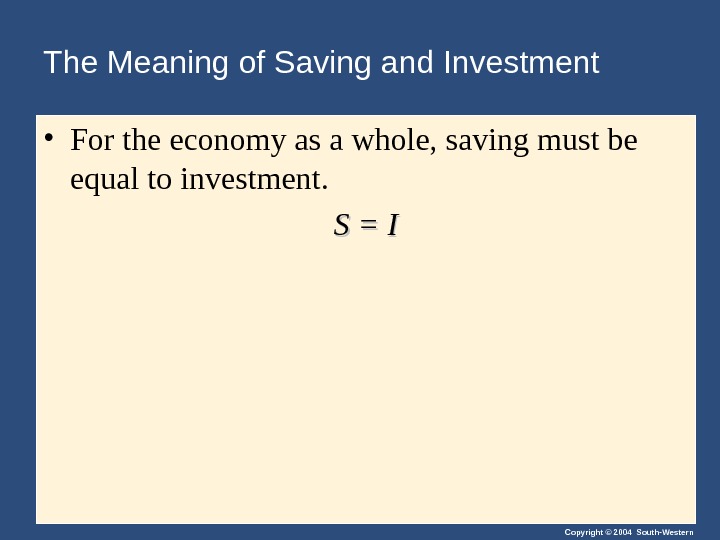
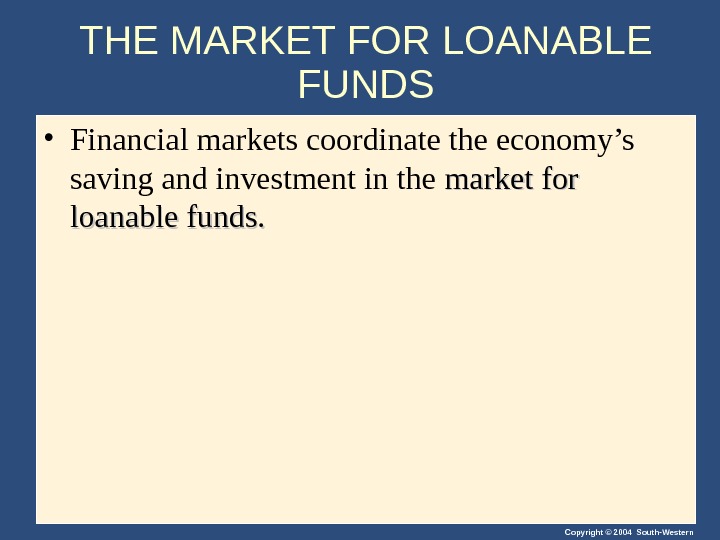
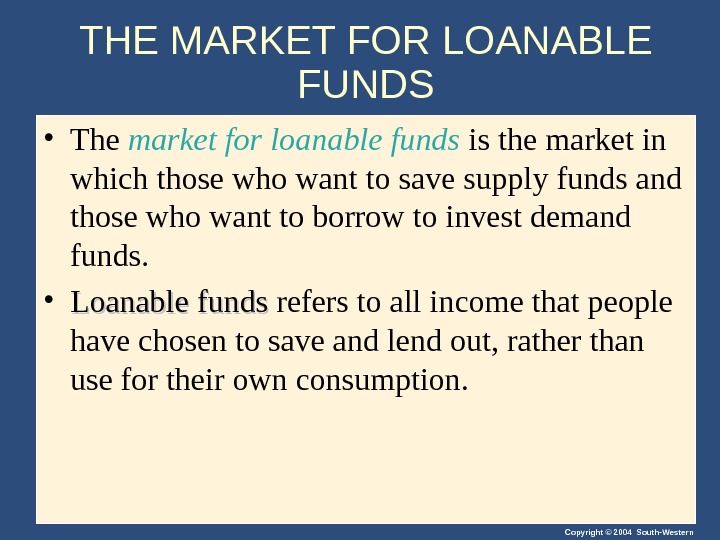
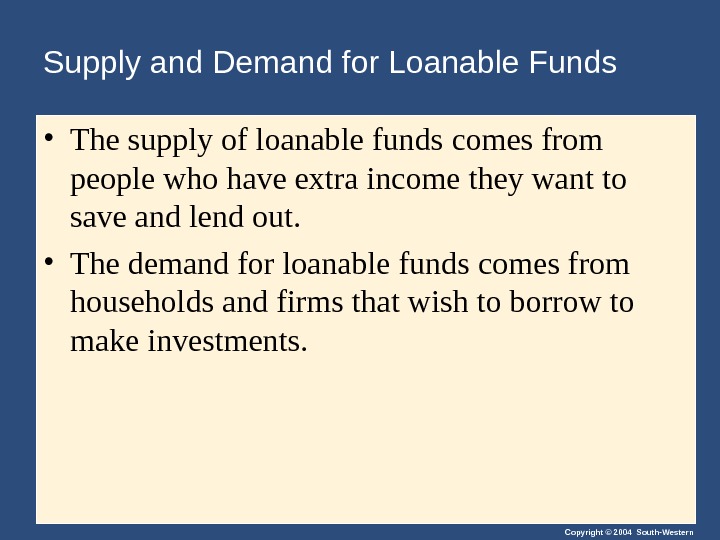
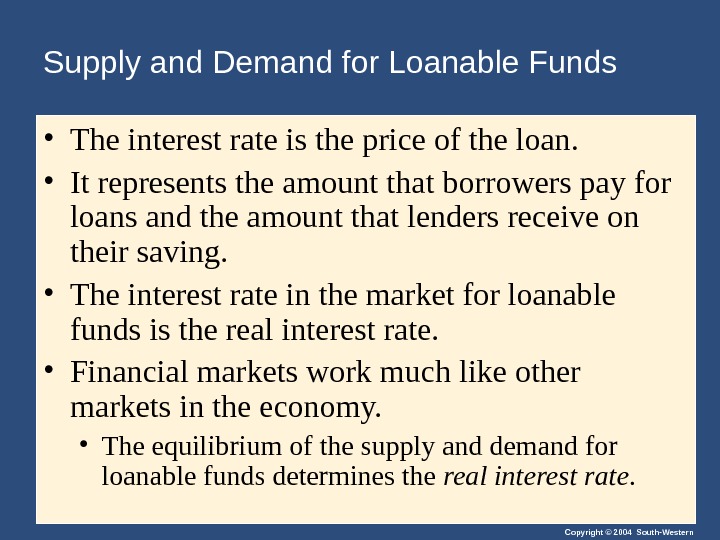
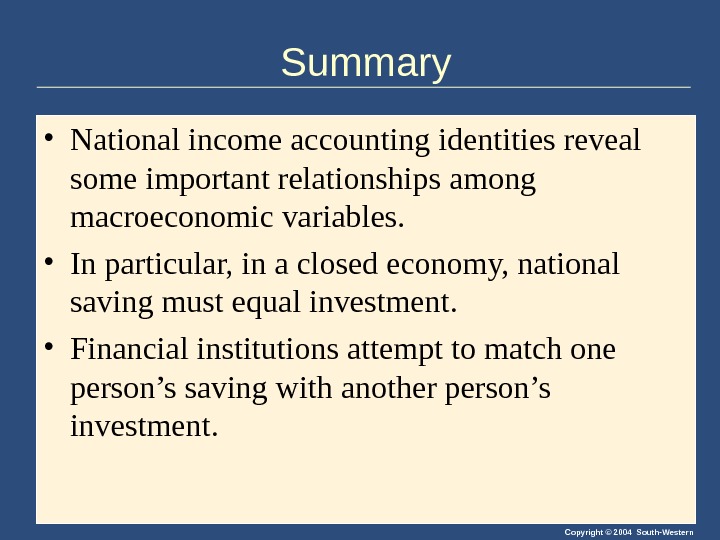
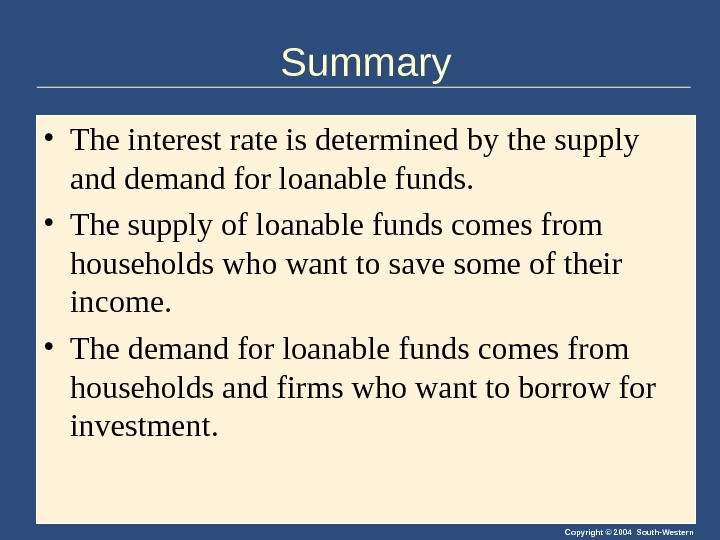
11_saving_investment.ppt
- Размер: 1 Mегабайта
- Количество слайдов: 20
Описание презентации Copyright © 2004 South-Western. Saving, Investment, and the по слайдам
 Copyright © 2004 South-Western. Saving, Investment, and the Financial System • The financial system consists of the group of institutions in the economy that help to match one person’s saving with another person’s investment. • It moves the economy’s scarce resources from savers to borrowers. • The financial system is made up of financial institutions that coordinate the actions of savers and borrowers. • Financial institutions can be grouped into two different categories: financial markets and financial intermediaries.
Copyright © 2004 South-Western. Saving, Investment, and the Financial System • The financial system consists of the group of institutions in the economy that help to match one person’s saving with another person’s investment. • It moves the economy’s scarce resources from savers to borrowers. • The financial system is made up of financial institutions that coordinate the actions of savers and borrowers. • Financial institutions can be grouped into two different categories: financial markets and financial intermediaries.
 Copyright © 2004 South-Western. FINANCIAL INSTITUTIONS IN THE U. S. ECONOMY • Financial Markets • Stock Market • Bond Market • Financial Intermediaries • Banks • Mutual Funds
Copyright © 2004 South-Western. FINANCIAL INSTITUTIONS IN THE U. S. ECONOMY • Financial Markets • Stock Market • Bond Market • Financial Intermediaries • Banks • Mutual Funds
 Copyright © 2004 South-Western. FINANCIAL INSTITUTIONS IN THE U. S. ECONOMY • Financial markets are the institutions through which savers can directly provide funds to borrowers. • Financial intermediaries are financial institutions through which savers can indirectly provide funds to borrowers.
Copyright © 2004 South-Western. FINANCIAL INSTITUTIONS IN THE U. S. ECONOMY • Financial markets are the institutions through which savers can directly provide funds to borrowers. • Financial intermediaries are financial institutions through which savers can indirectly provide funds to borrowers.
 Copyright © 2004 South-Western. Financial Markets • The Bond Market • A bond is a certificate of indebtedness that specifies obligations of the borrower to the holder of the bond. • Characteristics of a Bond • Term : The length of time until the bond matures. • Credit Risk : The probability that the borrower will fail to pay some of the interest or principal. • Tax Treatment : The way in which the tax laws treat the interest on the bond. • Municipal bonds are federal tax exempt.
Copyright © 2004 South-Western. Financial Markets • The Bond Market • A bond is a certificate of indebtedness that specifies obligations of the borrower to the holder of the bond. • Characteristics of a Bond • Term : The length of time until the bond matures. • Credit Risk : The probability that the borrower will fail to pay some of the interest or principal. • Tax Treatment : The way in which the tax laws treat the interest on the bond. • Municipal bonds are federal tax exempt.
 Copyright © 2004 South-Western. Financial Markets • The Stock Market • Stock represents a claim to partial ownership in a firm and is therefore, a claim to the profits that the firm makes. • The sale of stock to raise money is called equity financing. • Compared to bonds, stocks offer both higher risk and potentially higher returns. • The most important stock exchanges in the United States are the New York Stock Exchange, the American Stock Exchange, and NASDAQ. ( National Association of Securities Dealers Automated Quotations )
Copyright © 2004 South-Western. Financial Markets • The Stock Market • Stock represents a claim to partial ownership in a firm and is therefore, a claim to the profits that the firm makes. • The sale of stock to raise money is called equity financing. • Compared to bonds, stocks offer both higher risk and potentially higher returns. • The most important stock exchanges in the United States are the New York Stock Exchange, the American Stock Exchange, and NASDAQ. ( National Association of Securities Dealers Automated Quotations )
 Copyright © 2004 South-Western. Financial Markets • The Stock Market • Most newspaper stock tables provide the following information: • Price (of a share) • Volume (number of shares sold) • Dividend (profits paid to stockholders) • Price-earnings ratio
Copyright © 2004 South-Western. Financial Markets • The Stock Market • Most newspaper stock tables provide the following information: • Price (of a share) • Volume (number of shares sold) • Dividend (profits paid to stockholders) • Price-earnings ratio
 Copyright © 2004 South-Western. Financial Intermediaries • Financial intermediaries are financial institutions through which savers can indirectly provide funds to borrowers. • Banks • take deposits from people who want to save and use the deposits to make loans to people who want to borrow. • pay depositors interest on their deposits and charge borrowers slightly higher interest on their loans.
Copyright © 2004 South-Western. Financial Intermediaries • Financial intermediaries are financial institutions through which savers can indirectly provide funds to borrowers. • Banks • take deposits from people who want to save and use the deposits to make loans to people who want to borrow. • pay depositors interest on their deposits and charge borrowers slightly higher interest on their loans.
 Copyright © 2004 South-Western. Financial Intermediaries • Banks help create a medium of exchange by allowing people to write checks against their deposits. • A medium of exchanges is an item that people can easily use to engage in transactions. • This facilitates the purchases of goods and services. • Mutual Funds • A mutual fund is an institution that sells shares to the public and uses the proceeds to buy a portfolio, of various types of stocks, bonds, or both. • They allow people with small amounts of money to easily diversify.
Copyright © 2004 South-Western. Financial Intermediaries • Banks help create a medium of exchange by allowing people to write checks against their deposits. • A medium of exchanges is an item that people can easily use to engage in transactions. • This facilitates the purchases of goods and services. • Mutual Funds • A mutual fund is an institution that sells shares to the public and uses the proceeds to buy a portfolio, of various types of stocks, bonds, or both. • They allow people with small amounts of money to easily diversify.
 Copyright © 2004 South-Western. Financial Intermediaries • Other Financial Institutions • Credit unions • Pension funds • Insurance companies • Loan sharks
Copyright © 2004 South-Western. Financial Intermediaries • Other Financial Institutions • Credit unions • Pension funds • Insurance companies • Loan sharks
 Copyright © 2004 South-Western. Some Important Identities • Recall that GDP is both total income in an economy and total expenditure on the economy’s output of goods and services: Y = C + I + G + NX • Assume a closed economy – one that does not engage in international trade: Y = C + I + G
Copyright © 2004 South-Western. Some Important Identities • Recall that GDP is both total income in an economy and total expenditure on the economy’s output of goods and services: Y = C + I + G + NX • Assume a closed economy – one that does not engage in international trade: Y = C + I + G
 Copyright © 2004 South-Western. Some Important Identities • Now, subtract C and G from both sides of the equation: Y – C – G =I • The left side of the equation is the total income in the economy after paying for consumption and government purchases and is called national saving, or just saving (S). • Substituting S for Y — C — G , the equation can be written as: S = I
Copyright © 2004 South-Western. Some Important Identities • Now, subtract C and G from both sides of the equation: Y – C – G =I • The left side of the equation is the total income in the economy after paying for consumption and government purchases and is called national saving, or just saving (S). • Substituting S for Y — C — G , the equation can be written as: S = I
 Copyright © 2004 South-Western. The Meaning of Saving and Investment • National Saving • National saving is the total income in the economy that remains after paying for consumption and government purchases. • Private Saving • Private saving is the amount of income that households have left after paying their taxes and paying for their consumption. Private saving = (Y – T – C) • Public Saving • Public saving is the amount of tax revenue that the government has left after paying for its spending. Public saving = (T – G)
Copyright © 2004 South-Western. The Meaning of Saving and Investment • National Saving • National saving is the total income in the economy that remains after paying for consumption and government purchases. • Private Saving • Private saving is the amount of income that households have left after paying their taxes and paying for their consumption. Private saving = (Y – T – C) • Public Saving • Public saving is the amount of tax revenue that the government has left after paying for its spending. Public saving = (T – G)
 Copyright © 2004 South-Western. The Meaning of Saving and Investment • Surplus and Deficit • If T > G , the government runs a budget surplus because it receives more money than it spends. • The surplus of T — G represents public saving. • If G > T , the government runs a budget deficit because it spends more money than it receives in tax revenue.
Copyright © 2004 South-Western. The Meaning of Saving and Investment • Surplus and Deficit • If T > G , the government runs a budget surplus because it receives more money than it spends. • The surplus of T — G represents public saving. • If G > T , the government runs a budget deficit because it spends more money than it receives in tax revenue.
 Copyright © 2004 South-Western. The Meaning of Saving and Investment • For the economy as a whole, saving must be equal to investment. S = I
Copyright © 2004 South-Western. The Meaning of Saving and Investment • For the economy as a whole, saving must be equal to investment. S = I
 Copyright © 2004 South-Western. THE MARKET FOR LOANABLE FUNDS • Financial markets coordinate the economy’s saving and investment in the market for loanable funds.
Copyright © 2004 South-Western. THE MARKET FOR LOANABLE FUNDS • Financial markets coordinate the economy’s saving and investment in the market for loanable funds.
 Copyright © 2004 South-Western. THE MARKET FOR LOANABLE FUNDS • The market for loanable funds is the market in which those who want to save supply funds and those who want to borrow to invest demand funds. • Loanable funds refers to all income that people have chosen to save and lend out, rather than use for their own consumption.
Copyright © 2004 South-Western. THE MARKET FOR LOANABLE FUNDS • The market for loanable funds is the market in which those who want to save supply funds and those who want to borrow to invest demand funds. • Loanable funds refers to all income that people have chosen to save and lend out, rather than use for their own consumption.
 Copyright © 2004 South-Western. Supply and Demand for Loanable Funds • The supply of loanable funds comes from people who have extra income they want to save and lend out. • The demand for loanable funds comes from households and firms that wish to borrow to make investments.
Copyright © 2004 South-Western. Supply and Demand for Loanable Funds • The supply of loanable funds comes from people who have extra income they want to save and lend out. • The demand for loanable funds comes from households and firms that wish to borrow to make investments.
 Copyright © 2004 South-Western. Supply and Demand for Loanable Funds • The interest rate is the price of the loan. • It represents the amount that borrowers pay for loans and the amount that lenders receive on their saving. • The interest rate in the market for loanable funds is the real interest rate. • Financial markets work much like other markets in the economy. • The equilibrium of the supply and demand for loanable funds determines the real interest rate.
Copyright © 2004 South-Western. Supply and Demand for Loanable Funds • The interest rate is the price of the loan. • It represents the amount that borrowers pay for loans and the amount that lenders receive on their saving. • The interest rate in the market for loanable funds is the real interest rate. • Financial markets work much like other markets in the economy. • The equilibrium of the supply and demand for loanable funds determines the real interest rate.
 Copyright © 2004 South-Western. Summary • National income accounting identities reveal some important relationships among macroeconomic variables. • In particular, in a closed economy, national saving must equal investment. • Financial institutions attempt to match one person’s saving with another person’s investment.
Copyright © 2004 South-Western. Summary • National income accounting identities reveal some important relationships among macroeconomic variables. • In particular, in a closed economy, national saving must equal investment. • Financial institutions attempt to match one person’s saving with another person’s investment.
 Copyright © 2004 South-Western. Summary • The interest rate is determined by the supply and demand for loanable funds. • The supply of loanable funds comes from households who want to save some of their income. • The demand for loanable funds comes from households and firms who want to borrow for investment.
Copyright © 2004 South-Western. Summary • The interest rate is determined by the supply and demand for loanable funds. • The supply of loanable funds comes from households who want to save some of their income. • The demand for loanable funds comes from households and firms who want to borrow for investment.
